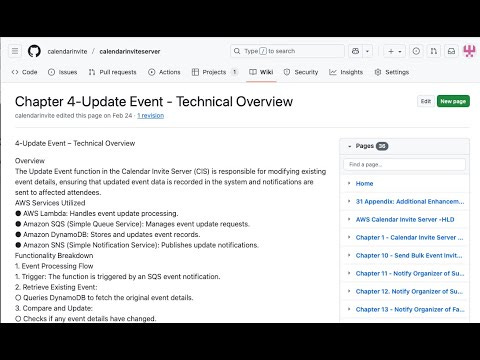What is the primary purpose of the Calendar Invite Server (CIS) Update Event function?
The primary purpose of the Update Event function within the Calendar Invite Server (CIS) is to enable the modification of existing event details. It ensures that any changes to an event are accurately recorded in the system and that all affected attendees are promptly notified of these updates.
Which AWS services are essential for the Update Event function to operate?
The Update Event function relies on several key AWS services for its operation:
AWS Lambda: This service is responsible for processing the event update requests.
Amazon SQS (Simple Queue Service): SQS manages the incoming event update requests, acting as a queue.
Amazon DynamoDB: This NoSQL database stores and updates the event records, maintaining data integrity.
Amazon SNS (Simple Notification Service): SNS is used to publish update notifications to attendees and other relevant parties.
How does the Event Processing Flow work when an event is updated?
The event processing flow for an update is a streamlined, automated sequence:
Trigger: The entire process begins when an SQS event notification triggers the Lambda function.
Retrieve Existing Event: The function then queries DynamoDB to retrieve the original, current details of the event.
Compare and Update: It compares the new event details with the original ones. If any modifications are detected, the event record in DynamoDB is updated.
Send Notifications: Once the event is updated, the function publishes update requests to SNS, which then sends notifications to attendees.
Cleanup: Finally, the successfully processed messages are deleted from the SQS queue to prevent redundant processing.
What are the main functional components or key functions within the Update Event process?
The Update Event process is broken down into several key functions:
lambda_handler(event, *): This is the entry point, iterating through SQS records and calling process_request_from.
process_request_from(record): Extracts update details, fetches the original event from DynamoDB, updates it if necessary, publishes SNS notifications, and deletes the SQS message.
get_event_uid_from(uid): Queries DynamoDB to retrieve a specific original event record.
event_updated(original_event, new_event): Compares the original and new event details to determine if an update is genuinely needed.
update_event(original_event, new_event): Performs the actual update of the event record in DynamoDB and increments its sequence number.
send_notification_of_updated(event): Publishes an SNS message to inform attendees of the event update.
delete_successfully_processed_sqs(message): Removes processed messages from SQS to avoid reprocessing and ensure idempotency.
How does the system handle data storage for events?
Event data is primarily stored in Amazon DynamoDB as "Event Records." Each event record has a primary key (pk) and sort key (sk), both formatted as event#. These records contain essential event metadata, including timestamps, the event's current status, and details about the organizer.
What environmental variables are necessary for configuring the Update Event function?
The function relies on several environmental variables for its configuration and proper operation:
REGION: Specifies the AWS region where the function will execute.
DYNAMODB_TABLE: Defines the name of the DynamoDB table where event records are stored.
SQS_URL: Provides the URL of the SQS queue used for processing event updates.
EVENT_UPDATED_SNS_ARN: Represents the Amazon Resource Name (ARN) of the SNS topic for sending update notifications.
What mechanisms are in place for error handling within the Update Event function?
The Update Event function incorporates several error-handling mechanisms to maintain robustness:
Invalid Update Requests: If a required field is missing from an update request, the request is logged for review but skipped, preventing it from halting the entire process.
DynamoDB Update Failures: Issues encountered during DynamoDB updates are logged for troubleshooting purposes, but they do not prevent the function from executing.
Exception Logging: A general exception logging mechanism is in place to capture and log any other errors that may occur, which greatly assists in debugging and maintaining the system.
What is the overall benefit of using AWS Lambda, SQS, DynamoDB, and SNS together for event updates?
By integrating AWS Lambda, SQS, DynamoDB, and SNS, the Calendar Invite Server's Update Event function achieves a highly automated, efficient, and reliable update process. This combination ensures that:
Scalability: The system can easily handle a large volume of update requests.
Resilience: Messages are queued, reducing the risk of data loss or missed updates.
Data Integrity: Event changes are consistently recorded in a managed database.
Timely Communication: Attendees are quickly notified of any modifications.
Operational Efficiency: The entire update workflow is automated, reducing manual intervention and potential errors.
AI Vid
Briefing Document: Calendar Invite Server (CIS) - Update Event Function Technical Overview
Date: October 26, 2023
Source: Excerpts from "Chapter 4‐Update Event ‐ Technical Overview · calendarinvite/calendarinviteserver Wiki · GitHub"
Purpose: This document provides a detailed overview of the "Update Event" function within the Calendar Invite Server (CIS), outlining its purpose, architecture, functionality, data handling, and error management.
Executive Summary
The "Update Event" function is a critical component of the Calendar Invite Server (CIS), designed to modify existing event details efficiently, ensure data integrity, and promptly notify affected attendees. It leverages a serverless architecture built on AWS services, automating the entire update process from request reception to notification delivery.
Main Themes and Key Concepts
Automated Event Modification: The core purpose of this function is to automate the process of updating event details within the CIS. "The Update Event function in the Calendar Invite Server (CIS) is responsible for modifying existing event details, ensuring that updated event data is recorded in the system and notifications are sent to affected attendees."
Serverless Architecture with AWS Services: The function is built using a suite of AWS services, highlighting a scalable, event-driven, and managed infrastructure approach.
AWS Lambda: Serves as the compute engine, handling the execution of the event update processing logic.
Amazon SQS (Simple Queue Service): Acts as a message queue, managing incoming event update requests and decoupling the trigger from the processing logic.
Amazon DynamoDB: Utilized as the NoSQL database for "Stores and updates event records" and retrieving original event details.
Amazon SNS (Simple Notification Service): Used for publishing "update notifications" to attendees.
Event-Driven Processing Flow: The update process is initiated by an SQS event notification, following a well-defined sequence of actions to ensure accurate updates and timely notifications.
Trigger: "An SQS event notification triggers the function."
Retrieve Existing Event: Queries DynamoDB to fetch the original event details.
Compare and Update: Checks for modifications and updates the record in DynamoDB if changes are present. This includes "Increments the event sequence number" for version control.
Send Notifications: Publishes update requests to SNS.
Cleanup: Deletes successfully processed messages from SQS.
Modular Functionality: The update logic is broken down into several key, specialized functions, promoting code organization, reusability, and maintainability.
lambda_handler(event, *): The entry point, iterating through SQS records and calling process_request_from.
process_request_from(record): Extracts update details, queries DynamoDB, updates the event, publishes SNS notification, and deletes the SQS message.
get_event_uid_from(uid): Retrieves original event records from DynamoDB.
event_updated(original_event, new_event): Compares events to determine if an update is necessary.
update_event(original_event, new_event): Handles the actual update in DynamoDB and increments the event sequence number.
send_notification_of_updated(event): Publishes an SNS message to notify attendees.
delete_successfully_processed_sqs(message): Removes processed messages from the SQS queue.
Data Handling and Environmental Configuration:
DynamoDB Records: Event records are stored with a primary key (pk: event#) and sort key (sk: event#), containing essential metadata like timestamps, status, and organizer details.
Environmental Variables: Critical configuration parameters are managed via environmental variables, ensuring flexibility and ease of deployment across different environments. These include REGION, DYNAMODB_TABLE, SQS_URL, and EVENT_UPDATED (SNS topic ARN).
Robust Error Handling: The function incorporates mechanisms to gracefully manage common issues, preventing system failures and aiding in debugging.
Invalid Update Requests: "If a required field is missing, the request is logged and skipped."
DynamoDB Update Failures: "Logged for troubleshooting but do not halt execution."
Exception Logging: "Logs errors to facilitate debugging."
Most Important Ideas/Facts
Core Purpose: The "Update Event" function is essential for maintaining accurate event information and ensuring attendees are informed of changes.
AWS Service Stack: The reliance on AWS Lambda, SQS, DynamoDB, and SNS demonstrates a modern, scalable, and resilient cloud-native approach.
Event Sequence Number: The incrementing of the event sequence number during an update is a crucial detail for tracking changes and potentially for versioning or conflict resolution.
Decoupled Architecture: The use of SQS and SNS highlights a decoupled architecture, improving system resilience and scalability by allowing components to operate independently.
Comprehensive Error Logging: The explicit mention of logging for invalid requests, DynamoDB failures, and general exceptions indicates a strong focus on operability and troubleshooting.
Conclusion
The "Update Event" function within the Calendar Invite Server is a well-designed, automated system that efficiently manages event modifications. Its robust architecture, built on key AWS services, ensures data integrity, timely notifications, and includes provisions for effective error handling, contributing significantly to the overall reliability and user experience of the CIS.












